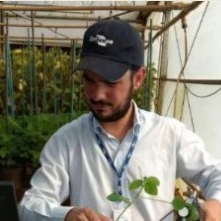Intelligent Remote Sensing in Smart Agriculture: From Early Identification to Yield Prediction—A Comprehensive Solution
A special issue of Agronomy (ISSN 2073-4395). This special issue belongs to the section "Precision and Digital Agriculture".
Deadline for manuscript submissions: 31 August 2024 | Viewed by 890
Special Issue Editors
Interests: multi-source remote sensing data fusion algorithm and application; crop classification and yield estimation; surface evapotranspiration and crop drought monitoring
Special Issues, Collections and Topics in MDPI journals
Interests: hyperspectral; multispectral; remote sensing; crop monitoring
Interests: remote sensing; resources and environment monitoring; fire detection; deep learning; geographic information system
Special Issues, Collections and Topics in MDPI journals
Special Issue Information
Dear Colleagues,
We cordially invite you to submit papers to the Special Issue of the open access journal "Agronomy" titled "Intelligent Remote Sensing in Smart Agriculture: From Early Identification to Yield Prediction—A Comprehensive Solution."
Intelligent remote sensing technology plays a crucial role in smart agriculture, particularly in areas like early crop identification, health monitoring, and yield prediction. When combined with advanced data analysis methods, these technologies offer more accurate and efficient management approaches for agricultural production. This Special Issue aims to gather research articles that explore and showcase the latest advancements and applications of intelligent remote sensing technology in smart agriculture. The contributions may include, but are not limited to, the following topics:
- Integration of Satellite and UAV Data: exploring the integration of satellite sensors, UAVs, and ground observation data in smart agriculture, especially in early crop identification and growth monitoring.
- Intelligent Early Warning Systems: researching how to use remote sensing data and intelligent analysis techniques to build early warning systems, improving the management efficiency of crop health and growth conditions.
- Smart Agriculture Yield Estimation: analyzing the application of remote sensing technology in monitoring crop biomass, vegetation cover, and growth rate, as well as the development and implementation of yield prediction models using various methods (such as empirical statistical models, crop models, light-use efficiency models, deep learning and machine learning algorithms, etc.).
- Resource Management and Environmental Protection: discussing how accurate yield predictions can aid in the effective management of agricultural resources and the reduction of environmental impacts.
- Analysis of the Impact of Climate Change: studying the impact of climate change on agricultural crop growth patterns and exploring adaptive agricultural strategies.
- Soil Health Monitoring: utilizing remote sensing technology to assess soil quality, providing data support for soil management and improvement.
We look forward to your submissions!
Prof. Dr. Liang Sun
Dr. Luis Guilherme Teixeira Crusiol
Dr. Maofang Gao
Guest Editors
Manuscript Submission Information
Manuscripts should be submitted online at www.mdpi.com by registering and logging in to this website. Once you are registered, click here to go to the submission form. Manuscripts can be submitted until the deadline. All submissions that pass pre-check are peer-reviewed. Accepted papers will be published continuously in the journal (as soon as accepted) and will be listed together on the special issue website. Research articles, review articles as well as short communications are invited. For planned papers, a title and short abstract (about 100 words) can be sent to the Editorial Office for announcement on this website.
Submitted manuscripts should not have been published previously, nor be under consideration for publication elsewhere (except conference proceedings papers). All manuscripts are thoroughly refereed through a single-blind peer-review process. A guide for authors and other relevant information for submission of manuscripts is available on the Instructions for Authors page. Agronomy is an international peer-reviewed open access monthly journal published by MDPI.
Please visit the Instructions for Authors page before submitting a manuscript. The Article Processing Charge (APC) for publication in this open access journal is 2600 CHF (Swiss Francs). Submitted papers should be well formatted and use good English. Authors may use MDPI's English editing service prior to publication or during author revisions.
Keywords
- remote sensing
- smart agriculture
- agriculture monitoring
- identification
- yield prediction







